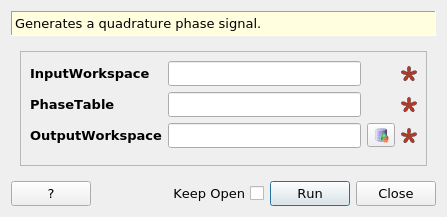\(\renewcommand\AA{\unicode{x212B}}\)
PhaseQuad v1¶

PhaseQuad dialog.¶
Summary¶
Generates a quadrature phase signal.
Overview¶
This algorithm provides a method for combining signals from multiple detector segments to form two output signals in quadrature phase. It is of particular use when working with muon spin rotation signals measured using highly segmented detector arrays that are typically found at pulsed muon sources (ISIS has instruments with up to 600 detector elements). The method allows information from individual detectors to be combined in a way that makes full use of the dataset.
This algorithm is frequently run as a precursor to making a Rotating Reference Frame transformation of the dataset using the algorithm RRFMuon v1. Both algorithms are fully described in the article by T.M. Riseman and J.H. Brewer [Hyp. Int., 65, (1990), 1107].
See Also¶
Properties¶
Name |
Direction |
Type |
Default |
Description |
|---|---|---|---|---|
InputWorkspace |
Input |
Mandatory |
Name of the input workspace containing the spectra |
|
PhaseTable |
Input |
Mandatory |
Name of the table containing the detector phases and asymmetries |
|
OutputWorkspace |
Output |
Mandatory |
Name of the output workspace |
Description¶
Assuming that the InputWorkspace contains measured counts as a function of time, and PhaseTable contains the detector phases and asymmetries, the algorithm returns a workspace containing two spectra (squashograms) as a function of the same time binning. If there are zero measured counts for a detector it is ignored in the calculation. PhaseTable is expected to have three columns, corresponding to the detector id, its asymmetry and its phase.
Usage¶
Note
To run these usage examples please first download the usage data, and add these to your path. In Mantid this is done using Manage User Directories.
Example - Computing squashograms:
from math import pi
Load(Filename='MUSR00022725.nxs', OutputWorkspace='MUSR00022725')
CropWorkspace(InputWorkspace='MUSR00022725', OutputWorkspace='MUSR00022725', XMin=0, EndWorkspaceIndex=63)
# Create a PhaseTable with some arbitrary detector information
tab = CreateEmptyTableWorkspace()
tab.addColumn('int', 'DetID')
tab.addColumn('double', 'Phase')
tab.addColumn('double', 'Asym')
for i in range(0,32):
phi = 2*pi*i/32.
tab.addRow([1, 0.2, phi])
for i in range(0,32):
phi = 2*pi*i/32.
tab.addRow([1, 0.2, phi])
ows = PhaseQuad(InputWorkspace='MUSR00022725', PhaseTable='tab')
print("Output workspace has {} histograms".format(ows.getNumberHistograms()))
Output:
Output workspace has 2 histograms
Categories: AlgorithmIndex | Muon
Source¶
C++ header: PhaseQuadMuon.h
C++ source: PhaseQuadMuon.cpp
